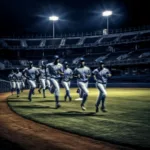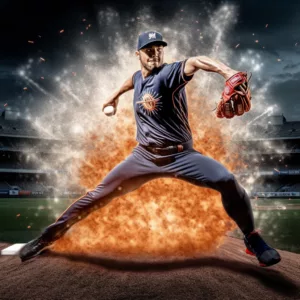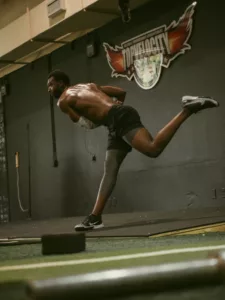 Are you wondering Why do pitchers run after pitching? This article will expose the myth and provide you with the lates science!
Are you wondering Why do pitchers run after pitching? This article will expose the myth and provide you with the lates science!
Pitchers play an important role in baseball's dynamic world. Pitching necessitates a delicate combination of strength, skill, and endurance. Running after pitching is one of the tactics used by pitchers to improve their effectiveness and recuperation. It poses some interesting considerations. Why do pitchers sprint after throwing? What effect does it have on their arm feelings and overall conditioning? This essay will look at the various facets of this discipline, backed up by insights from Brent Pourciau's professional baseball experience and TopVelocity programs.
Why do pitchers run after pitching? Arm Sensations and Recovery
The Day-After Sensation: Arm Improvement
 Before diving into the specifics of this subject, it's critical to distinguish between chronic and acute pain and discomfort. The underlying causes of a pitcher's ongoing arm soreness and discomfort might include conditions such as impingement, tendonitis, or even partial tears (3). It's crucial to note, however, that long slow distance (LSD) jogging isn't a cure-all for persistent arm discomfort. The infrequent or fleeting arm discomfort experienced after pitching by a healthy pitcher is generally the consequence of microtrauma—a succession of microscopic rips in the muscles used during throwing. This microtrauma is commonly caused by overuse injuries, which are frequently connected with repetitive strain or poor mechanics that occur during constant competition (8). Baseball pitching, in particular, is a significant cause of these overuse injuries (3).
Before diving into the specifics of this subject, it's critical to distinguish between chronic and acute pain and discomfort. The underlying causes of a pitcher's ongoing arm soreness and discomfort might include conditions such as impingement, tendonitis, or even partial tears (3). It's crucial to note, however, that long slow distance (LSD) jogging isn't a cure-all for persistent arm discomfort. The infrequent or fleeting arm discomfort experienced after pitching by a healthy pitcher is generally the consequence of microtrauma—a succession of microscopic rips in the muscles used during throwing. This microtrauma is commonly caused by overuse injuries, which are frequently connected with repetitive strain or poor mechanics that occur during constant competition (8). Baseball pitching, in particular, is a significant cause of these overuse injuries (3).
It's critical to note that there's an additional element to this equation: secondary damage, which involves the inflammatory response caused by the microtrauma to the affected muscles involved in the throwing motion.
A 30-45 minute exercise the day after pitching can significantly improve the sensation in the pitcher's throwing arm. This improvement can be ascribed to increased oxygenated blood circulation and a rise in muscle temperature, both of which contribute to a perception of pain reduction (8). The increased blood flow increases the presence of white blood cells (leukocytes) and antibodies in the microtrauma-affected area while effectively cleaning out undesirable compounds. Furthermore, the increased muscular temperature has a relaxing effect. This action contributes to pain relief, decreased muscular tension, and decreased soreness and stiffness (8). As a result, the muscles and connective tissues in the throwing arm have more suppleness and less viscosity. Simply put, the arm feels more supple and pleasant as a result of the increased blood circulation and warmth. As a result, whether it's LSD running or any type of exercise that increases blood flow and raises the temperature of the pitching arm, the healing process is aided by the use of thermotherapy.
Dispelling the Lactic Acid Myth of Soreness
 Long slow distance (LSD) conditioning can enhance blood circulation throughout the body, resulting in less stiffness in the pitcher's throwing arm. However, it's important to note that this form of training has no direct effect on "flushing out" lactic acid from the pitcher's arm. Contrary to popular assumption, lactic acid levels do not rise sufficiently to impair a pitcher's performance. It's worth noting that a pitcher's lactate levels may be slightly higher if they've thrown a high number of pitches in a short inning with minimum rest periods. Nonetheless, due to the average time gap between pitches for college pitchers, which often runs between 15 and 20 seconds (2,6), such occurrences are extremely uncommon in baseball games.
Long slow distance (LSD) conditioning can enhance blood circulation throughout the body, resulting in less stiffness in the pitcher's throwing arm. However, it's important to note that this form of training has no direct effect on "flushing out" lactic acid from the pitcher's arm. Contrary to popular assumption, lactic acid levels do not rise sufficiently to impair a pitcher's performance. It's worth noting that a pitcher's lactate levels may be slightly higher if they've thrown a high number of pitches in a short inning with minimum rest periods. Nonetheless, due to the average time gap between pitches for college pitchers, which often runs between 15 and 20 seconds (2,6), such occurrences are extremely uncommon in baseball games.
Furthermore, if a pitcher experiences tiredness and hence increased lactate levels, they might purposefully slow down the game by increasing the time between throws. If this technique fails, the pitcher should expect a recovery to normal blood lactate levels while resting on the bench during their team's batting phase after their inning of play. Furthermore, considerable lactic acid accumulation (greater than 12 mmol/L) does not occur during the pitching process. Instead, depending on the recovery strategy used post-exercise, these levels would naturally return to baseline levels 40 to 60 minutes after engaging in high-intensity exercise (9).
Potteiger et al. (6) did research that revealed intriguing results. They discovered no significant variations in blood lactate levels before and after throwing (0.76 mmol/L) in six collegiate baseball pitchers who participated in a simulated 7-inning game. This study found that there isn't a significant quantity of lactic acid in the pitcher's arm that needs to be "flushed" out, even after a 24-hour or longer period following the throwing event.
Unraveling Soreness in the Throwing Arm
 There are times when a healthy pitcher would have more discomfort than usual, which could be caused by factors other than the inflammatory reaction. Research provides insight into the physiological changes that occur when a person engages in unfamiliar or high-intensity exercise with a significant eccentric component (9). Pitchers may feel increased soreness and stiffness from time to time, which could be due in part to delayed-onset muscular soreness (DOMS). DOMS refers to the soreness and stiffness that commonly accompany new or increased intensity levels of physical activity. This sensation usually peaks 24 to 48 hours after the workout and fades within 96 hours (9).
There are times when a healthy pitcher would have more discomfort than usual, which could be caused by factors other than the inflammatory reaction. Research provides insight into the physiological changes that occur when a person engages in unfamiliar or high-intensity exercise with a significant eccentric component (9). Pitchers may feel increased soreness and stiffness from time to time, which could be due in part to delayed-onset muscular soreness (DOMS). DOMS refers to the soreness and stiffness that commonly accompany new or increased intensity levels of physical activity. This sensation usually peaks 24 to 48 hours after the workout and fades within 96 hours (9).
This viewpoint is founded on anecdotal experience from the current author, who brings to the table both prior playing experiences and current coaching insights. It's important to note that not all instances of soreness are caused by DOMS; rather, this explanation applies to situations in which a pitcher throws more pitches than usual (given that the average number of pitches per inning in college baseball is 16) or extends their innings beyond their usual threshold. Because of the significant eccentric forces exerted on the throwing arm during the deceleration phase (when the arm slows down after releasing the ball), combined with an increased pitch count per inning or a number of innings, it's possible that the strain on the throwing arm's musculature is amplified. This stress is particularly damaging to muscles such as the latissimus dorsi, posterior deltoid, rotator cuff muscles, rhomboids, teres major, and trapezius (3).
The position of the pitcher's pain and stiffness throughout their body is determined by their pitching mechanics and release point. Surprisingly, the body's reaction to DOMS serves as a protective mechanism. If a pitcher repeats a similar performance that resulted in DOMS, the body protects itself from additional harm. There is currently no single effective strategy for reducing DOMS. Our bodies naturally experience DOMS for 2-3 days before experiencing alleviation as part of a physiological adaptation process.
Why do pitchers run after pitching? A Pitcher's Energy Needs
 To create an effective pitching training program, it is necessary to first understand the bioenergetic mechanisms at work. Aerobic metabolism is a series of chemical reactions that require the presence of oxygen in order to produce adenosine triphosphate (ATP) and water. When our bodies engage in activities of "light" to "moderate" intensity, often ranging from 50% to 76% of our maximal heart rate (1), this system comes to the fore.
To create an effective pitching training program, it is necessary to first understand the bioenergetic mechanisms at work. Aerobic metabolism is a series of chemical reactions that require the presence of oxygen in order to produce adenosine triphosphate (ATP) and water. When our bodies engage in activities of "light" to "moderate" intensity, often ranging from 50% to 76% of our maximal heart rate (1), this system comes to the fore.
Anaerobic metabolism, on the other hand, involves a series of events that do not require oxygen to generate ATP. The anaerobic metabolism, which includes creatine phosphate and glycolysis, is activated during high-intensity activities (ranging from 77% to 94% of maximal heart rate) and activities characterized by brief, maximal-intensity bursts. Because pitching is a compact, high-intensity movement, its major energy system is classified as anaerobic (7). According to Mathews and Fox (5), the energy supply mechanisms during pitching are 95% ATP-PC (creatine phosphate system) and 5% glycolysis (glucose breakdown). According to Fox (4), pitching's energy allocation is roughly 90% anaerobic and 10% aerobic. Whatever viewpoint one takes, the essential message remains the same: pitching's repetitive activities involve brief bursts of high energy followed by long periods of rest (7).
Several main variables must be considered when designing a conditioning program for pitchers: the anaerobic energy systems at work, the workouts that efficiently target these energy systems, and the optimum exercise intensity (expressed as a percentage of maximum heart rate). The concept of using the proportion of age-predicted maximal heart rate (% HRmax) as a variable in baseball pitchers is one that coaches frequently neglect.
Join the 3X Velocity Camp to Unlock Your Pitching Potential!
 Are you prepared to take your pitching game to the next level? The 3X Velocity Camp provides a revolutionary experience for athletes who are committed to improving their pitching recovery and on-field ability. The 3X Velocity Camp is a baseball training beacon of excellence, with an unshakable dedication to evidence-based approaches and pitching science.
Are you prepared to take your pitching game to the next level? The 3X Velocity Camp provides a revolutionary experience for athletes who are committed to improving their pitching recovery and on-field ability. The 3X Velocity Camp is a baseball training beacon of excellence, with an unshakable dedication to evidence-based approaches and pitching science.
The 3X Velocity Camp, coached by industry-renowned professionals such as former professional pitcher Brent Pourciau, provides you with the knowledge, tools, and tactics to drive your pitching skills to new heights. Take advantage of cutting-edge approaches developed over years of expertise on and off the field.
Our camp isn't only about theory; it's also about practical results. By attending the 3X Velocity Camp, you will have access to top-tier programming that is scientifically supported and tailored to your specific needs. Our camp is your route to attaining unmatched success on the mound, from improving your recuperation strategies to harnessing the power of evidence-based performance methods.
Don't pass up this unique opportunity to learn from the best and reach your maximum pitching potential. Join the 3X Velocity Camp today and become a part of a community dedicated to baseball excellence, growth, and pushing the limits of what is possible.
Why do pitchers run after pitching? Begin The Better Training Right Now!
Visit 3X Velocity Camp to discover more about this life-changing experience and to reserve your position in the game's premier pitching program. Improve your performance, raise your game, and become the pitcher you've always wanted to be. The future of your pitching success begins right now!
FAQs: Why do pitchers run after pitching?
Q: Can jogging after pitching assist with arm soreness?
A: While jogging the day after pitching improves arm feelings, it does not directly reduce arm discomfort. Soreness is caused by a variety of physiological processes.
Q: What role does TopVelocity training have in pitching conditioning?
A: Brent Pourciau's TopVelocity programs blend science-backed approaches to improve players' innate abilities while reducing injury risks.
Q: What causes unusually sore throwing arms in pitchers?
A: Unusual pain may be caused by factors such as insufficient warm-up, poor mechanics, or overexertion during pitching.
Q: Can lactic acid create post-pitch muscle soreness?
A: Lactic acid is not the main cause of muscular discomfort after pitching. Pitchers' discomfort is exacerbated by additional causes.
Q: What effect does cardiovascular fitness have on pitching performance?
A: Cardiovascular health affects endurance and recovery, allowing pitchers to execute consistently throughout the game.
Q: How important is heart rate intensity in pitcher conditioning?
A: Research on heart rate intensity during pitching and conditioning aids in tailoring training programs to fit the sport's cardiovascular needs.
Reference: Why do pitchers run after pitching?
- American College of Sports Medicine. Chapter 1: Benefits and risks associated with physical activity. In: ACSM's Guidelines for Exercise Testing and Prescription (7th ed). Baltimore, MD: Lippincott Williams and Wilkins. 2006. pp. 4.
- Coleman AE. 52-Week Baseball Training. Champaign, IL: Human Kinetics, 2000.
- Fleisig GS, Andrews JR, Dillman CJ, and Escamilla RF. Kinetics of baseball pitching with implications about injury mechanisms. Am J Sports Med 23: 233-239, 1995.
- Fox EL. Sports Physiology (2nd ed). New York, NY: CBS College Publishing, 1984.
- Mathews DK and Fox EL. The Physiological Basis of Physical Education and Athletics. Philadelphia, PA: Saunders, 1976.
- Potteiger JA, Blessing DL, and Wilson GD. The physiological response to a single game of baseball pitching. J Appl Sport Sci Res 6: 11-18, 1992.
- Potteiger JA, Williford HN Jr, Blessing DL, and Smidt J. Effect of two training methods on improving baseball performance variables. J Appl Sport Sci Res 6: 2-6, 1992.
- Prentice WE. Therapeutic Modalities for Sports Medicine and Athletic Training (6th ed). New York, NY: McGraw-Hill, 2009.
- Szymanski DJ. Collegiate baseball in-season training. Strength Cond J 29(4): 68-80, 2007.




